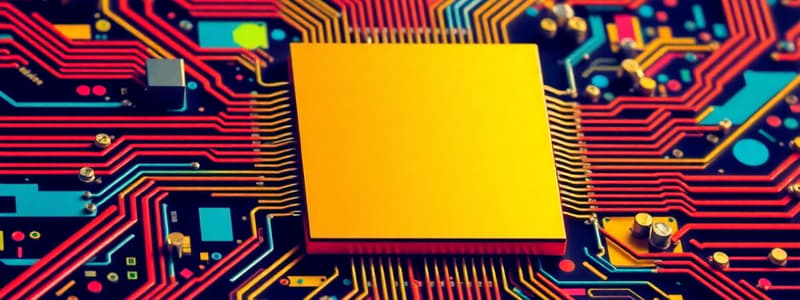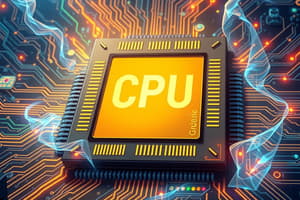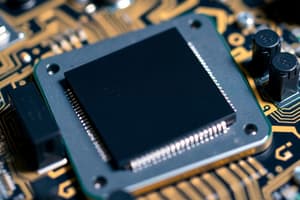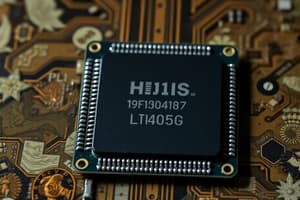Podcast
Questions and Answers
Which of the following is NOT a tool available at the hardware architecture level?
Which of the following is NOT a tool available at the hardware architecture level?
- Interrupts and Interrupt Vector
- Memory Management Unit
- System Call Interface (correct)
- Kernel/User Mode
What is the primary purpose of the interrupt vector?
What is the primary purpose of the interrupt vector?
- To store the current state of the CPU
- To provide direct access to I/O ports for user applications
- To manage memory allocation for processes
- To link hardware interrupts with the appropriate interrupt service routines (correct)
In the basic instruction cycle of the CPU, which step immediately follows fetching an instruction?
In the basic instruction cycle of the CPU, which step immediately follows fetching an instruction?
- Executing the instruction
- Checking for interrupts
- Saving the instruction to memory
- Incrementing the program counter (correct)
What distinguishes kernel mode from user mode?
What distinguishes kernel mode from user mode?
During a context switch, which of the following actions is essential for resuming the program later?
During a context switch, which of the following actions is essential for resuming the program later?
What happens to the Program Counter (PC) during an interrupt?
What happens to the Program Counter (PC) during an interrupt?
What is the purpose of 'masking off' interrupts?
What is the purpose of 'masking off' interrupts?
In the context of interrupt handling, what is the primary function of the 'Return from Interrupt' (RTI) instruction?
In the context of interrupt handling, what is the primary function of the 'Return from Interrupt' (RTI) instruction?
What characterizes a 'critical section' in concurrent programming?
What characterizes a 'critical section' in concurrent programming?
What is a potential risk if a critical section is not properly managed?
What is a potential risk if a critical section is not properly managed?
Which of the following is NOT a type of device driver in modern UNIX-type systems?
Which of the following is NOT a type of device driver in modern UNIX-type systems?
Which action is typically performed by the open function in a device driver?
Which action is typically performed by the open function in a device driver?
What is the role of the 'interrupt service routine' within device drivers?
What is the role of the 'interrupt service routine' within device drivers?
What does the term 'process context' refer to?
What does the term 'process context' refer to?
Which of the following is a primary function of the process table?
Which of the following is a primary function of the process table?
What is the key purpose of synchronization primitives?
What is the key purpose of synchronization primitives?
Which outcome does a 'mutex' intend to achieve when applied to a critical section?
Which outcome does a 'mutex' intend to achieve when applied to a critical section?
What is the fundamental operation of the signal operation on a semaphore?
What is the fundamental operation of the signal operation on a semaphore?
Which condition defines 'deadlock'?
Which condition defines 'deadlock'?
In the context of inter-process communication (IPC), what are 'signals' primarily used for?
In the context of inter-process communication (IPC), what are 'signals' primarily used for?
Which type of scheduling algorithm is generally considered 'fair' because jobs cannot be stuck waiting forever?
Which type of scheduling algorithm is generally considered 'fair' because jobs cannot be stuck waiting forever?
For interactive systems, what type of schedulers are generally required to achieve smoother response times?
For interactive systems, what type of schedulers are generally required to achieve smoother response times?
What is the primary characteristic of 'real-time' tasks in scheduling?
What is the primary characteristic of 'real-time' tasks in scheduling?
How do pipes facilitate inter-process communication?
How do pipes facilitate inter-process communication?
Which step, related to process state, is part of the basic process scheduler loop?
Which step, related to process state, is part of the basic process scheduler loop?
When is a device driver's probe function typically called?
When is a device driver's probe function typically called?
What is the purpose of the splx function in the context of device drivers?
What is the purpose of the splx function in the context of device drivers?
What is the purpose of the tsleep function in the context of device drivers?
What is the purpose of the tsleep function in the context of device drivers?
What is the purpose of the Java synchronized keyword
What is the purpose of the Java synchronized keyword
What is a software 'interrupt'?
What is a software 'interrupt'?
What is the normal pairing of signal and wait in semaphores?
What is the normal pairing of signal and wait in semaphores?
To avoid deadlock, what has to be avoided?
To avoid deadlock, what has to be avoided?
What is the signal used for in IPC?
What is the signal used for in IPC?
What defines FIFO?
What defines FIFO?
What describes SJF?
What describes SJF?
What describes batch processing?
What describes batch processing?
What describes interactive processing?
What describes interactive processing?
What describes real time processing?
What describes real time processing?
Flashcards
CPU (Central Processing Unit)
CPU (Central Processing Unit)
The core processing unit that executes instructions.
RAM (Random Access Memory)
RAM (Random Access Memory)
A type of computer memory that can be accessed randomly.
I/O Devices
I/O Devices
The connection points for external devices to a computer.
Interrupt vector
Interrupt vector
Signup and view all the flashcards
Processor status register
Processor status register
Signup and view all the flashcards
Instruction Cycle
Instruction Cycle
Signup and view all the flashcards
User mode
User mode
Signup and view all the flashcards
Kernel mode
Kernel mode
Signup and view all the flashcards
Context Switch
Context Switch
Signup and view all the flashcards
Interrupt
Interrupt
Signup and view all the flashcards
Masking off
Masking off
Signup and view all the flashcards
Return from interrupt
Return from interrupt
Signup and view all the flashcards
Critical section
Critical section
Signup and view all the flashcards
Block Device Drivers
Block Device Drivers
Signup and view all the flashcards
Network Device Drivers
Network Device Drivers
Signup and view all the flashcards
Character Device Driver
Character Device Driver
Signup and view all the flashcards
Top Half
Top Half
Signup and view all the flashcards
Bottom Half
Bottom Half
Signup and view all the flashcards
Get Keyb
Get Keyb
Signup and view all the flashcards
Circular Queue
Circular Queue
Signup and view all the flashcards
Spltty
Spltty
Signup and view all the flashcards
Tsleep
Tsleep
Signup and view all the flashcards
Wakeup
Wakeup
Signup and view all the flashcards
Get char from device
Get char from device
Signup and view all the flashcards
Process
Process
Signup and view all the flashcards
Process table
Process table
Signup and view all the flashcards
Deadlock
Deadlock
Signup and view all the flashcards
Java synchronized keyword
Java synchronized keyword
Signup and view all the flashcards
Semaphores/Mutexes
Semaphores/Mutexes
Signup and view all the flashcards
Signals
Signals
Signup and view all the flashcards
Signal Values
Signal Values
Signup and view all the flashcards
Pipes
Pipes
Signup and view all the flashcards
Preemptive Discipline
Preemptive Discipline
Signup and view all the flashcards
Round robin FIFO
Round robin FIFO
Signup and view all the flashcards
Shortest job
Shortest job
Signup and view all the flashcards
fair
fair
Signup and view all the flashcards
optimal
optimal
Signup and view all the flashcards
Int time system.
Int time system.
Signup and view all the flashcards
Study Notes
Computer Components
- Central Processing Unit (CPU)
- Random Access Memory (RAM)
- Input/Output (I/O) Devices
Actual Physical Memory Organization
- "Zero Page" contains the interrupt vector, I/O, and BIOS/ROMs if present
- Has an address range from 0x00...00
- RAM has an address range Ox??...??
Hardware Architecture Tools
- Program Counter (PC) tracks current instruction
- Stack Pointer/Frame Pointer
- Processor Status Register
- General Purpose Registers
- Memory Management Unit (MMU), for mapping and protection
- Kernel/User Mode
- Interrupts and interrupt vector
Interrupt Vector Function
- Links devices with service routines using function addresses
- Example devices: disk, CD, mouse, keyboard
Basic Instruction Cycle
- Fetch instruction pointed to by the PC
- Increment the PC
- Execute the instruction
- Process repeats
Processor Status
- User mode can execute most instructions, excluding I/O operations
- Kernel mode can execute all user instructions, as well as special instructions and registers for I/O and memory access
- Kernel mode called supervisor mode
Interrupt Vector
- Allocates a special range of locations in RAM
- Links hardware interrupts with interrupt service routines
Processes in Memory
- Consists of a process table entry, hardware kernel space and user space
- Shared memory is accessible from the user space and kernel space
- Requires interrupt signal
Program Execution
- Assembler translates code to machine code and designates a memory address
- Assembler, Machine Code and virtual memory addresses are used
- Registers include R0, R1, R2, R3, SP, and PC
- Op Codes dictate Load, Store, Increment, Decrement, Jump, Jump to Subroutine, Reserve Storage Bytes, and Zero
Context Switch Definition
- Process of changing from one running program to another "on the fly"
- Involves saving the "program state," mainly the program counter, general purpose registers, status register, and stack pointer
- Each program must reside indifferent parts of the memory
Time Chart
- Can be used to visualize context switching
- Program represented by a line
- Interrupts (disk or mouse) represented by vertical bars during the interrupt
- Context switches occur at points where programs switch due to interrupts
Interrupts Explained
- Trigger a hardware-generated jump to a subroutine (JSR)
- Initiated by an external hardware device, not the CPU
- Defined by an interrupt vector, which resides in physical memory as an array of function pointers
- Can be delayed via masking off
Interrupt Steps
- Saves Program Counter (PC) on the stack
- Switches the CPU to kernel (supervisor) mode
- Loads PC from a vector utilizing a hardware ID
- Vector contains the start address of the interrupt service routine
- Saves all registers and continues execution
Return from Interrupt (RTI) Steps
- Restore registers
- Restore saved PC value
- Set CPU to the previous mode
Critical Section Definition
- A code segment that references data shared among multiple "threads of control"
- Threads may include interrupts, processes, or multiple conventional threads
- Data must be managed so all parties can rely on its value
- Failure to manage could lead to incorrect or corrupted data
Critical Section Example
i++gets compiled to load R1, #i; incr R1; store R1, #i- Interrupts must be managed
Device Drivers
- Enable communication between hardware and the operating system
- Divided into three primary types in modern UNIX-like systems: BLOCK, NETWORK, and CHARACTER
Types of Device Drivers
- BLOCK: manage devices that read/write blocks, like disks and tapes
- NETWORK: handle local and remote network communications, such as Ethernet and PPP
- CHARACTER: manage devices that don't fit into the BLOCK or NETWORK categories (serial ports)
Device Driver Top Half Functions
- Interface with user and kernel level processes
- Primary operations include:
- Probe: Checks for hardware during boot time
- Open: Initialized when a process opens a device file
- Generates a file descriptor in user space.
- Close: Called when a process closes a device file to deallocate
- Read function copies data from device to process
- Write function queues the data for the device to output.
Device Driver Bottom Half Functions
- Focuses on event handling
- Manages interrupt service routines triggered when a device generates an interrupt, handling I/O on the hardware
Mutual Exclusion
- Must block interrupt signal to prevent conflicts in updating
- Uses
spltty()to prevent the second interrupt from overwriting the first. splx(int prev State)returns to a previous interrupt mask- Processes can be put to sleep if a buffer is full using
tsleep()and awoken usingwakeup()
Device Driver Skeleton - read
- Character variable Q is declared with a variable size QSIZE
- Sets starting variables for number in queue, start and end position in the queue
- Enters the
spltty()critical section to check that a device can be read - Enters a while loop conditioned upon the list being empty
- Enters an
sleept()critical section and then loop back to a newspltty()to check the device again - Copies the first character from the read queue into a variable and iterates the pointer
- Exits the
sleept()critical section
Device Driver Skeleton - intr
- Enters the
spltty()critical section to ensure nothing else reads at the same time - Conditional statement checks that the queue is not full
- Exits the
spltty()critical section and exits - If the queue isn't full it adds the first available character from the specified device
- Iterates the end of the queue
- Exits the critical section
- Signals to wakeup that data has been receieved
Running Programs in UNIX/Mach
- Execution of a program (image) is a process
- O/S provides a simplified pseudo-computer environment for program execution
- Process runs without direct access to I/O Ports
- Access through kernel calls
- Process has a virtual (simplified) address space and a process context
- UNIX/Mach process environment consists of registers, stack and other data
- Managed through process table entry
Process Table Contains
- Context (thread)
- Program counter
- Registers for general/special purposes
- Stack pointer
- Virtual address space reference
- Scheduling information, like blocked, runnable, or running status, priority and time used
Synchronization Primitives
- Handle data shared between processes/threads
- Manages critical sections that prevent data conflicts.
- Two main are mutex and semaphores
Mutex Definition
- Brackets a critical section to allow only one process at a time
- Prevents race conditions and ensures data integrity
Semaphore Definition
- Allows "N" processes to access a critical section at once
- Used to control access to resources
Semaphores: "signal" function
- Increments the internal counter of the semaphore
Semaphores: "wait" function
- Waits until the internal counter is greater than zero, and then decrements the counter
Mutex Synchronization
- Producer adds entries to the queue, and consumer removes them
- Ensures that two processes aren't writing to the same memory at the same time
Implementing Mutual Exclusion
- Achieved in hardware using special instructions like TEST_AND_SET
- These ensure indivisible operations, preventing race conditions
- Critical_begin sets the mutexFlag, and the critical_end resets it
Dekker's Algorithm
- A software approach to mutual exclusion for two processes
- Uses "need" flags and a "turn" variable to decide which process can enter the critical section
Semaphore Implementation with Mutexes
- Critical sections are used with signal and wait
- Professional implementations use tsleep() to block busy loops
Semaphore Producer/Consumer Example
- Uses two semaphores, available_sem and used_sem, to manage the buffer
- Critical sections are protected with semaphore to avoid race conditions
Co-Operating Sequential Processes
- Semaphores can be used to coordinate two sequential streams
Semaphore_t UandSemaphore_t DSEM_WAITandSEM_SIGNALare used
Semaphore Hints
- Semaphores must be properly initialized
- Always work from the definitions of wait_sem() and signal_sem()
- A wait_sem should have a corresponding signal_sem on the same semaphore
- The order of wait_sem operations is important, but the order of signal is less so
Deadlock Cause
- Occurs when processes hold resources and require resources already held by other processes
- Can be detected by the presence of a cycle in the resource allocation graph
Java synchronized Keyword
- Is used on a whole method or code block to provide a critical section
- Ensures that only one thread can access the synchronized section at a time
Inter-Process Communication (IPC) Mechanisms
- Shared Memory: Shared process image
- Semaphores/Mutexes: Integer values for flow control
- Signals: Software "interrupts"
- Pipes: Imitation file shared by processes
Signals Explained
- Signals can indicate an important event
- Process A runs, and Process B sends a signal
- Process A suspends and calls a signal handler
- Process A returns
- Process B sees no direct notification
Signal Values
- Represented by integers, similar to interrupts
- Include
HUP(hangup),INT(interrupt),QUIT(quit),ILL(illegal instruction),TRAP(trace trap), andKILL(kill process) - Some signals may vary between platforms
- Can use
kill -lcommand to know current configuration
Signal Example
- Example uses
#include <signal.h> signalHandlergets definedsignalcommand registers the handler
Pipes Explained
- A pair of file descriptors shared between processes
- Buffer is common to both processes
- Buffer not stored in the filesystem but in memory
Basic Process Scheduler Loop
- When a process can no longer run, it is marked Runnable or Blocked
- Save process context in the process table entry
- A new process is then found to be Runnable and is executed
- The state is then restored
Scheduling Algorithms
- Queuing Discipline
- Determines the order in which processes are executed
FIFO (First-In-First-Out)
- If processses repeatedly join the queue its called "round robin"
- Process is typically preemptive
- Processes handled in order of arrival.
SJF (Shortest Job First)
- Prioritizes the shortest jobs first
- May jump to the head of the queue
- It is nonpreemptive
Scheduling Algorithm Considerations
- FIFO & round robin are generally considered fair
- This is due being incapable of being stuck waiting forever
- SJF provides the largest throughput due to always running the fastest task
- SJF may be considered unfair due to processes being starved though
Scheduling In General
- Preemptive schedulers will perform better than non-preemptive and are required for interactive systems
- Schedulers will normally bias towards short jobs
- Operators/users can manually change by using the command
nice(1) - Always a trade-off between coarse and fine granularity
Scheduling Implementations
- Preemption occurs frequently results in 'processor sharing'
- The discipline is therefore FIFO
Batch Task
- Insensitive to runtime gaps
- Seeks overall task completion
Interactive Task
- Sensitive to runtime gaps
- Contains many I/O operations
Real-time Task
- Critically sensitive to runtime gaps
- Has a fixed fraction of CPU/unit requirements
Priority Queues
- VMS/Windows
- Some systems vary the priority dynamically; others do not
Studying That Suits You
Use AI to generate personalized quizzes and flashcards to suit your learning preferences.




